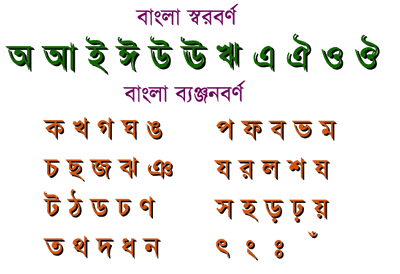

ঃ -h and ং -ng are also often used as abbreviation marks in Bengali, with ং -ng used when the next sound following the abbreviation would be a nasal sound, and ঃ -h otherwise. isn't pronounced, but geminates the following consonant, as in দুঃসময়.


Of the consonants in Bengali, ten are aspirated-that is, they sound as if an 'H' was appended to it. Here are the ones that will fit in one syllable: But in actual practiced Bangla, there are more diphthongs that are written by putting the vowels together or attaching them to the consonant য় ("ya" pronounced /yɔ/ and called the "semi-vowel অ"). The Bangla alphabet has only two single vowels representing diphthongs (ঐ and ঔ). Moreover, depending on context, the graphs অ and এ can sound like o and â, respectively.

There is no symbol for the vowel sound â (like the a in English bat) in the basic inventory of Bengali script, so the ligature অ্যা is used instead. ঐ and ঔ are used to denote two diphthongs, although there are many more diphthongs in use in Bengali. Although ঋ is a vowel in Sanskrit, it is pronounced in Bengali as /ri/, a consonant-vowel combination. These vowel letters were initially adopted from the Devanagari script that is used to write Sanskrit and Hindi. You must try to use the IPA whenever possible. ^2 This letter is obsolete: now the character for it represents the number 9.Īlways keep in mind that the English pronunciations are only approximations. ^1 In theory they should be lengthened /iː/ and /uː/, but in spoken Bangla this is not the case. However, ই and উ also have prefix 'hrôshsho', and ঈ and ঊ suffix 'dirgho'. Vowels are referred to by their sound and are suffixed by '-kar' when referring to a conjunct.


 0 kommentar(er)
0 kommentar(er)
